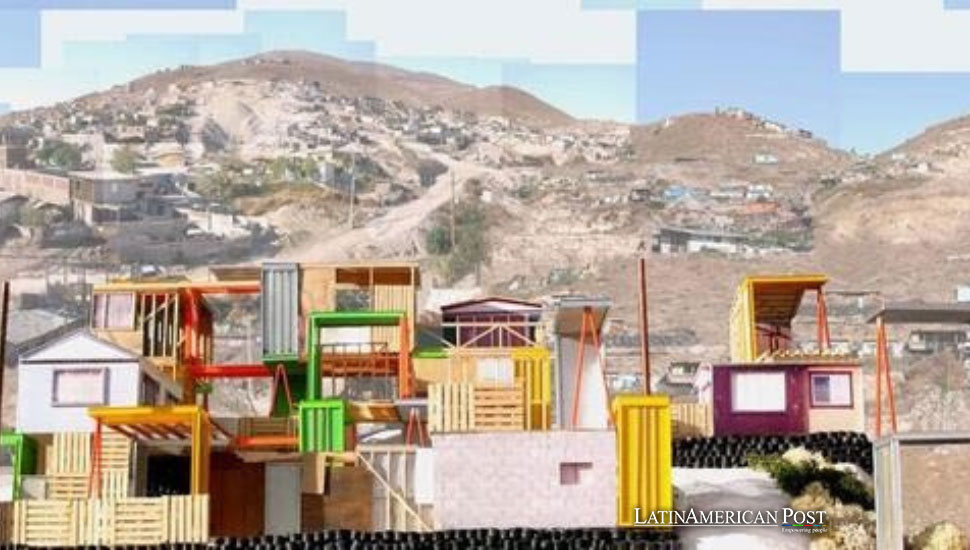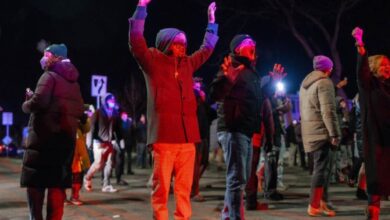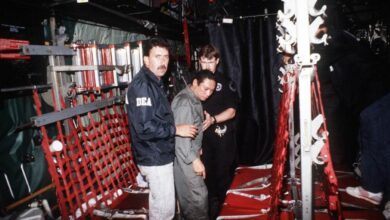Latin American Migrants’ Innovations Transform U.S. Urban Living

A first-of-its-kind sanctuary neighborhood for migrants on the San Diego-Tijuana border exemplifies Latin American urban innovations. Bloomberg featured how the UCSD-Alacrán Community Station is shaping the future of urban living for migrants. This is in an adapted version of that report.
Over the last few years, a first-of-its-kind sanctuary neighborhood for migrants opened in a canyon next to the San Diego-Tijuana border wall. A sanctuary neighborhood, a concept that originated in Latin America, is a community designed to provide a safe and supportive environment for migrants, offering not just shelter but also access to essential services and opportunities for cultural and social integration. The UCSD-Alacrán Community Station, created through a partnership with the University of California San Diego Center on Global Justice, houses around 1,800 people; the three-acre site also features a health care clinic, food hub, school, and outdoor plaza. More than an emergency shelter, Alacrán is designed to help those fleeing violence in their countries of origin actively shape the social, cultural, and economic life of the ad-hoc city they now call home.
UCSD-Alacrán is one of four cross-border community stations—two in Tijuana, two in San Diego—that the Center on Global Justice launched with local nonprofits and school districts. Their inspiration comes from the Colombian cities of Bogotá and Medellín, says Teddy Cruz, the center’s director of urban research. As these cities emerged from years of drug cartel violence in the 1990s and early 2000s, they implemented a variety of experimental social policies to improve urban life, from hiring mimes to direct traffic to building a network of library parks in high-poverty neighborhoods. According to Cruz and center founding director Fonna Forman, the idea was to rebuild patterns of trust and social cooperation from the ground up.
Learning from Latin American Cities
In November 2023, the UCSD-Alacrán Community Station hosted a significant event-the appearance of Little Amal, a 12-foot-tall puppet representing a 10-year-old Syrian refugee girl. This event underscored the community station’s pivotal role in fostering a sense of belonging and cultural integration. According to Cruz and Forman, the goal is not just to apply similar ideas about the value of social infrastructure to the US-Mexico border zone, but to actively reshape the political dialogue nationwide. “We have been convinced,” Cruz and Forman said in an email, “that it is in Latin American cities where we can find the DNA for reclaiming a new public imagination in the US.” This emphasis on the role of Latin American cities in shaping the political narrative is sure to engage and interest the audience.
Importing urban innovations from Latin America has been around for a while. The gold standard for enlightened city-making has focused on central and northern Europe for decades. US planners often cite the bike lanes of Amsterdam, the superblocks of Barcelona, and the “15-minute city” model of Paris. However, as migration strains city coffers and climate change fuels population shifts, Latin American cities are attracting fresh interest from practitioners and academics seeking solutions to the most pressing urban challenges in the US. What sets Latin American urban innovations apart is their unique approach to community integration and their ability to address the specific challenges faced by migrants.
Juan Miró, a professor of architecture at the University of Texas, Austin, notes that European best practices have proven ill-equipped to address many urban challenges. “People go to Paris and say: ‘It’s so beautiful, a model high-density city,’” he said. “But go to the outskirts where immigrants are, and they are terrible places to live.” The features that define US urban life—extreme income inequality and sprawling 20th-century development patterns—are also seen throughout Latin America. Both regions share the same “arc of history,” Miró said: colonization, Indigenous decimation, slavery, and independence. “Despite all their problems,” Miró said, “the Americas are way ahead of Europe regarding coexistence issues.”
Community-Based Fixes
Latin America’s robust tradition of developing grassroots solutions partly reflects the region’s history of government instability and dysfunction, said Lucia Nogales, a Madrid-based architect and urban planner and former director of Ocupa tu Calle, an activist public space organization in Lima. This bottom-up approach can be a model both for the US and Europe, where many policymakers now fret about flagging faith in public institutions and growing polarization. The potential of Latin American grassroots solutions to inspire change is not just a possibility, but a reality that can motivate and empower the audience.
“What I discovered in Latin America and what is missing here is the sense of community,” said Nogales, a research fellow for the NetZeroCities project. “Community is not a romantic idea,” she added, but a concept necessary for “rethinking how democracy works.” Mexico City’s colossal scale and environmental precarity have made it a vibrant source of creative interventions. Miró takes his students to study modern housing typologies and those in Teotihuacan, a nearby pre-Hispanic city. One of the largest cities in the world in the 5th century, Teotihuacan offers lessons on how cities can adapt equitably to climate change, said Miró, explaining that modest residences and palaces were designed with the same solar orientation. “High or low, the common principle was integration with nature.”
In today’s Mexico City, policymakers are pondering ways to make the megacity more equitable for those on its margins. Since 2019, it has opened a series of 13 parks and community centers across its most populous borough, Iztapalapa, known for its high crime and poverty rates. The evocatively named Utopias provide a wide range of public services, including digital design and animation classes, job assistance and entrepreneurship workshops, Olympic-size swimming pools, movie theaters, and safe spaces for victims of domestic violence.
A Culture of Adaptation
Daniel Escotto, director of the postgraduate public space and urban mobility program at the School of Architecture at the National Autonomous University of Mexico, explains the initiative: “We are trying to create a playful city. We dedicate everything to that concept. Because city culture is not maintained by law enforcement but by playing.” Accordingly, many of the facilities assume a decidedly whimsical aesthetic. Utopia Meyehualco features a life-size dinosaur sculpture park; Barco Utopia opened in a ship-shaped building last year. A similar initiative brings 287 small community hubs known as Pilares—a Spanish acronym for “Points of Innovation, Freedom, Art, Education and Knowledge.” These library-like spaces, designed by local architects, offer public services, such as meeting rooms and job assistance, to predominantly low-income neighborhoods.
“Mexico City is a polycentric city that is sectorized, ghettoized—we cannot recompact the city,” said Escotto, who previously served as the director and coordinator of public space for the federal government and Mexico City. Instead, the Pilares and Utopias bring the city’s social infrastructure and geographical sprawl. “We are trying to equalize the quality of life for people in the poorest belts of the city,” he said.
The growing interest in Latin American urbanism among US planners partially reflects migration trends and population shifts. In six of the ten most populous US cities, Latinos are the single biggest demographic group. In Los Angeles County, just under half of residents are now Hispanic or Latino. Elsewhere, new immigrants from Latin America are reviving economies and refilling cities that had been losing population, including Detroit and Minneapolis, said Andrew Sandoval-Strausz, director of Latino Studies at Penn State University.
Building Social Ties
Migrants are restoring the social fabric in their way, Sandoval-Strausz emphasized. “Migrants are not building new structures or street grids. The key observation is these things are enacted, not designed.” James Rojas, a community activist and urban planner from East LA who founded the Latino Urban Forum, points to the recent legalization of informal sidewalk street vendors across the city—long a source of local conflict—as a sign of the influence that Latino urbanism now has on LA’s policy landscape.
“American planning is based on transactions and businesses, law and order,” he said. “Whereas Latinos are always looking for the social space. They buy a house and turn the front yard into a plaza.” That informal social dynamic is at the heart of Latino urbanism, the understanding that goals like walkability and small-scale economic development have long occurred organically across Latin America. Planners like Rojas and Nogales say that harnessing this approach as urban policy can help address the fraying civic ties and “epidemic” of loneliness often said to afflict US cities.
In the recently published book Citizen-Led Urbanism in Latin America, Nogales and several co-authors assemble a compendium of examples of livability, transportation, and public space initiatives led by residents of cities across the region, often spawned in response to political and environmental crises. “This is the century of migration, and we view that as a problem,” said Nogales. But city leaders can learn much from migrant communities, where the self-organizing traditions of the urban and rural poor have spawned microeconomy networks and vibrant social spaces. By integrating these grassroots innovations into urban planning, cities can create more inclusive, resilient, and dynamic communities.




